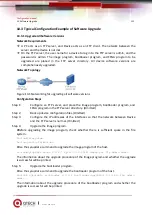
Configuration manual
11. Bootloader
117
www.qtech.ru
11
BOOTLOADER
11.1
Overview
In an embedded system, Bootloader runs before the Operating System (OS) kernel runs.
Bootloader is used to initialize hardware devices (including the Console port, Ethernet port,
and flash), and set up memory space mapping to bring the hardware and software of the
system to a proper state. Finally, it prepares a proper environment for booting the OS kernel.
In the embedded system, there is no such firmware program as BIOS, so the booting of the
entire system is implemented by the Bootloader.
The Bootloader system mainly provides the following functions:
Sets startup parameter to load the image program, and select the loading mode of the
Image program.
Upgrades the Bootloader program.
11.2
Bootloader Function Configuration
Table 11-1 Bootloader function configuration list
Configuration Tasks
Set the Bootloader boot parameters
Set the Bootloader boot parameters
Upgrade the Bootloader program
Upgrade the Bootloader program
11.2.1
Preparation before Configuring the Bootloader Functions
Before configuring the Bootloader functions, you need to set up a local configuration
environment. Connect the serial port of the host (or terminal) to the Console port of the device
through a configuration cable. The configuration of the communication parameters of the host
(or terminal) must be the same as the default configuration of the Console port of the device.
The default configuration of the Console port of the device is as follows:
Transmission speed: 9600 bps
Flow control mode: None
Check mode: None
Stop bit: 1 bit
Data bit: 8 bits
11.2.2
Set the Bootloader Boot Parameters
Configuration Condition
None
Set bootloader Boot Parameters
Table 11-2 Set the Bootloader boot parameters




































